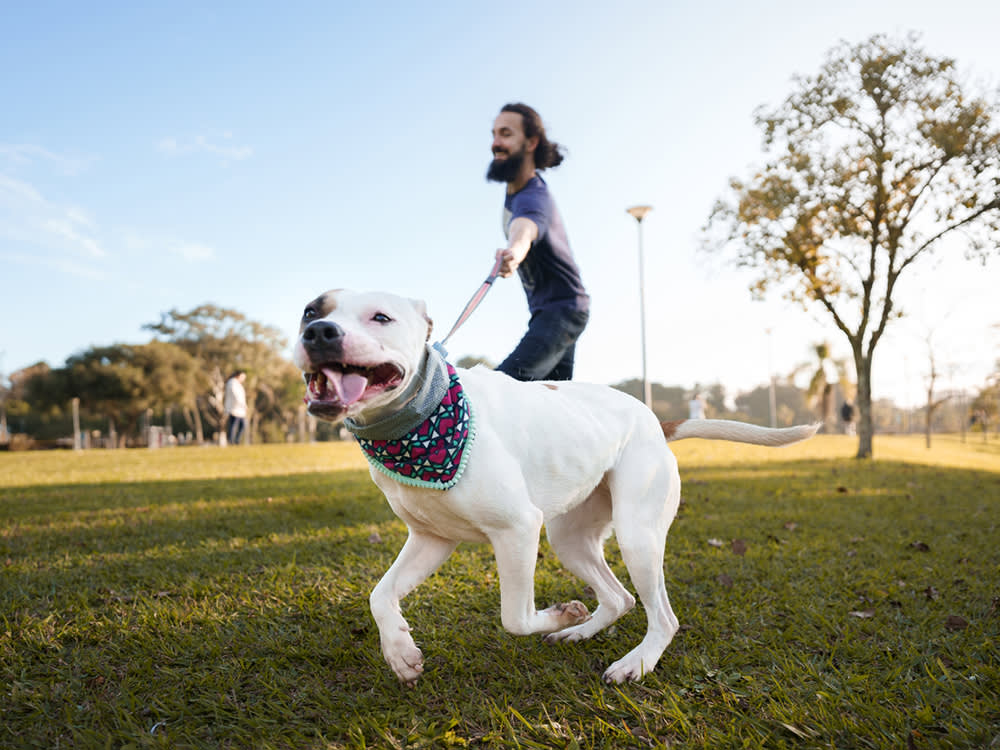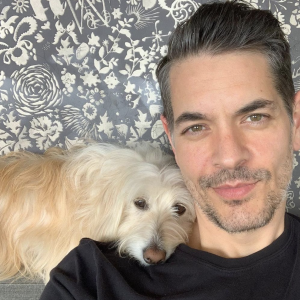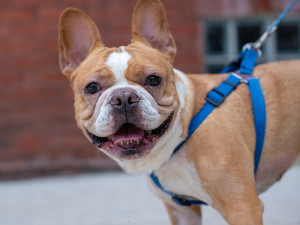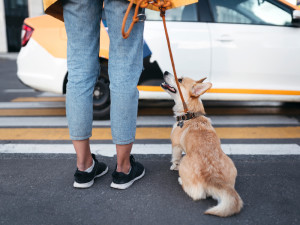“How Do I Get My Dog to Stop Pulling on the Leash?”
Dog trainer Robert Haussmann’s tips for turning a stressful walk into a chill stroll.

share article
Lola is my five-month-old Shepherd / Labrador Retriever mix. We adopted her about a week ago from a foster home. She starts off great when we go on walks, but after about five minutes, she is constantly pulling and zig-zagging. I keep the leash all wrapped up so she has to walk next to me, but she still keeps pulling. Stopping and redirecting her doesn’t seem to work. The minute we start walking again, she starts to pull. I’m not sure what to do next. — Ines
Congratulations on your adoption! Leash-pulling is a super common problem for dogs, especially puppies like Lola who are just learning how to walk on a leash. The good news is it sounds like Lola’s an eager, curious puppy — and with a little guidance, she can explore her new neighborhood safely and calmly.
First, identify your dog’s motivation and remove distractions.
The first thing we need to do is identify what it is that’s motivating the behavior of pulling. It could be that a dog is fearful and overwhelmed by environmental stimuli, and they’re trying to escape. Alternately, it could be that they’re super jazzed to sniff around and explore their environmentopens in a new tab. In either case, we need to make staying by your side seem like the best option to your dog.
You can do this using positive reinforcement, a.k.a. lots of treatsopens in a new tab. Don’t be shy about the number of treats you give, because you can always fade food out of the equation over time. You might want to plan your training around Lola’s feeding schedule so that she has an empty stomach during training, and she’s extra motivated by food rewards. Use these high-value rewards in an environment where Lola is not distracted, whether that’s a yard or hallway or courtyard — anywhere your dog can pay full attention to you. Start where the dog can hear you and focus on you. Eventually, you can slowly increase the challenges present, bringing Lola to more and more distracting environments.
Avoid following their pull, and avoid pulling back.
Allowing a dog to pull and following them with tension on the leash just reinforces pulling. The dog learns that pressure on the neck means forward movement, which is what’s motivating their behavior. In other words: your dog wants to move forward, and if you move them forward when they pull, they’re gonna want to keep pulling.
At the same time, yanking your dog or correcting them could add stress, and we don’t want to add stress to training — this could lead to reactivity issues down the line. Dogs have something called an oppositional reflex. What that means is when pressure is applied to them, they have the natural instinct to push or pull back. It’s not because they’re disobedient; it’s how they’re hardwired. Because of their oppositional reflex, yanking a dog or holding a dog’s leash too tightly near you just makes the problem worse. You want to aim for a loose, slack leash.
Level up your equipment.
If a dog is really strong, as Lola will probably be when she’s grown up, you might need a piece of equipment that gives you more control without adding pain. We want to control using leverage, not suppress using force.
No-pull harnessesopens in a new tab are a good start. That’s a harness where the leash attaches in front of the dog on the chest area, which is right in front of the dog’s center of gravity. When the dog goes to pull forward, they can’t as easily engage the pressure on the leash and pull you. You can also give them a bit of a pull back and interrupt their forward momentum without hurting their neck and restricting their airways.
If the harness isn’t effective or your dog is improving but occasionally jolts out of line, a head collar is another potential solution. A head collar is a bit more intrusive to a dog than the harness, so it does take some time to desensitize your dog to be comfortable wearing it. It doesn’t operate on pain, but it fits around a dog’s snout, so some dogs have trouble getting used to it. The device operates on leverage; it’s similar to a horse bridle.
Keep in mind that the training has to happen with or without equipment. The harness or head collar can help you get in front of a dog’s ability to use their body weight to pull you forward, but it won’t solve the problem. Plus, your training regimen with your dog is a bond the two of you form together, and it will be the greatest tool to problem solve in the future.

Robert Haussmann, CPDT-KA
Robert Haussman founded Dogboy NYC in 2005 to help pets navigate the urban jungle that is New York City using creative, practical, and humane training methods. Haussmann is a Certified Professional Dog Trainer and Canine Behavior Consultant, specializing in helping dogs overcome behavioral issues including fear, phobias, anxiety, and aggression. He advises owners on the best practices for making their dogs feel safe at home and beyond.
Related articles
- opens in a new tab
How to Train a Dog Not to Jump
The Wildest Collective dog trainer Robert Haussmann’s pro tips for getting a hyped-up dog to chill out.
- opens in a new tab
“How Can I Curb My Dog’s Squirrel Obsession?”
Dog trainer Robert Haussmann’s pro tips for walking a pup that wants to chase everything that moves.
![Dog looks up at owner on a walk through the city]() opens in a new tab
opens in a new tab7 Ways to Stop Your Dog from Scavenging on Walks
If your dog tries to scarf down literally everything in sight, you need this advice.





